
a.
To determine: The present values and the future values.
The present value refers to that value which is the current value computed for future amounts based on the discounted rate.
The future value means that value of the investment which will be realized in the future. With the help of the calculation of future value, an analysis of the amount to be invested can be made.
b.
To determine: The present values and the future values.
Present Value:
The present value refers to that value which is the current value computed for future amounts based on the discounted rate.
Future Value:
The future value means that value of the investment which will be realized in the future. With the help of the calculation of future value, an analysis of the amount to be invested can be made.
c.
To determine: The present values and the future values.
Present Value:
The present value refers to that value which is the current value computed for future amounts based on the discounted rate.
Future Value:
The future value means that value of the investment which will be realized in the future. With the help of the calculation of future value, an analysis of the amount to be invested can be made.
d.
To determine: The present values and the future values.
Present Value:
The present value refers to that value which is the current value computed for future amounts based on the discounted rate.
Future Value:
The future value means that value of the investment which will be realized in the future. With the help of the calculation of future value, an analysis of the amount to be invested can be made.
Want to see the full answer?
Check out a sample textbook solution
Chapter 5 Solutions
Fundamentals of Financial Management, Concise Edition (MindTap Course List)
- What is the primary goal of financial management? A) Maximizing revenuesB) Minimizing costsC) Maximizing shareholder wealthD) Increasing market share need help!arrow_forwardThe time value of money concept assumes that: A) A dollar today is worth more than a dollar in the future B) A dollar in the future is worth more than a dollar today C) Money loses value only when interest rates rise D) Money value remains constant over time need help!!arrow_forwardWhat does ROI stand for in finance? A) Return on InvestmentB) Revenue on InvestmentC) Rate of InterestD) Risk of Investment need answer!arrow_forward
- The time value of money concept assumes that: A) A dollar today is worth more than a dollar in the futureB) A dollar in the future is worth more than a dollar todayC) Money loses value only when interest rates riseD) Money value remains constant over timearrow_forwardWhat is the primary goal of financial management? A) Maximizing revenuesB) Minimizing costsC) Maximizing shareholder wealthD) Increasing market sharearrow_forwardA bond’s face value is: A) The price at which the bond is bought B) The amount paid to the bondholder at maturity C) The interest rate of the bond which option is correct?arrow_forward
- What does ROI stand for in finance? A) Return on InvestmentB) Revenue on InvestmentC) Rate of InterestD) Risk of Investmentneed exparrow_forwardA bond’s face value is: A) The price at which the bond is bought B) The amount paid to the bondholder at maturity C) The interest rate of the bond D) The amount of annual coupon paymentsi need help in this question!arrow_forwardA bond’s face value is: A) The price at which the bond is bought B) The amount paid to the bondholder at maturity C) The interest rate of the bond D) The amount of annual coupon paymentsarrow_forward
- A public company’s value can be calculated by different approaches depending on the data available and are often shared through quarterly or annual reports, or financial statements. If a financial and investment analyst for a publicly traded company, understanding that I may be asked to give a presentation on how the company uses performance metrics in corporate valuation. How would I present return on equity (ROE) and earnings per share (EPS) to a group of investors or senior management. Reviewiing a publicly traded company’s ROE and EPS. Although What do these results say about the company?arrow_forwardA stock’s beta coefficient is a measure of its: A) Dividend yield B) Risk in relation to the market C) Earnings growth rate D) Market pricearrow_forwardNo AI Which of the following is NOT a characteristic of common stock? A) Voting rights B) Dividends C) Guaranteed return on investment D) Ownership in the companyarrow_forward
 Essentials Of InvestmentsFinanceISBN:9781260013924Author:Bodie, Zvi, Kane, Alex, MARCUS, Alan J.Publisher:Mcgraw-hill Education,
Essentials Of InvestmentsFinanceISBN:9781260013924Author:Bodie, Zvi, Kane, Alex, MARCUS, Alan J.Publisher:Mcgraw-hill Education,

 Foundations Of FinanceFinanceISBN:9780134897264Author:KEOWN, Arthur J., Martin, John D., PETTY, J. WilliamPublisher:Pearson,
Foundations Of FinanceFinanceISBN:9780134897264Author:KEOWN, Arthur J., Martin, John D., PETTY, J. WilliamPublisher:Pearson, Fundamentals of Financial Management (MindTap Cou...FinanceISBN:9781337395250Author:Eugene F. Brigham, Joel F. HoustonPublisher:Cengage Learning
Fundamentals of Financial Management (MindTap Cou...FinanceISBN:9781337395250Author:Eugene F. Brigham, Joel F. HoustonPublisher:Cengage Learning Corporate Finance (The Mcgraw-hill/Irwin Series i...FinanceISBN:9780077861759Author:Stephen A. Ross Franco Modigliani Professor of Financial Economics Professor, Randolph W Westerfield Robert R. Dockson Deans Chair in Bus. Admin., Jeffrey Jaffe, Bradford D Jordan ProfessorPublisher:McGraw-Hill Education
Corporate Finance (The Mcgraw-hill/Irwin Series i...FinanceISBN:9780077861759Author:Stephen A. Ross Franco Modigliani Professor of Financial Economics Professor, Randolph W Westerfield Robert R. Dockson Deans Chair in Bus. Admin., Jeffrey Jaffe, Bradford D Jordan ProfessorPublisher:McGraw-Hill Education





